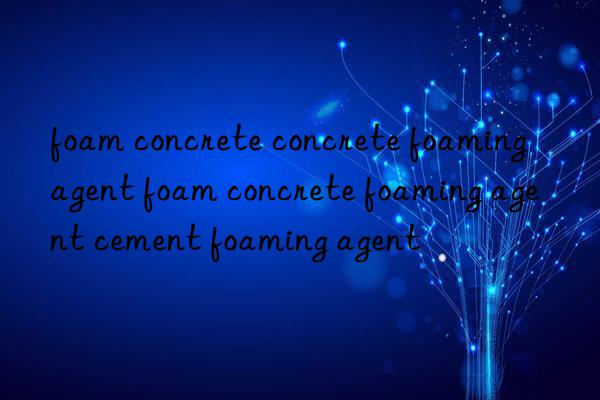
Foaming agents can be used in cement, fly ash, gypsum, magnesium oxide, lime, river sand, sawdust, refractory mud and other building materials that can be mixed with water to produce lightweight bricks, wallboards and cement foaming agents. How to use: 1. Improve the workability and cohesion of concrete, reduce segregation and bleeding, and improve freeze-thaw resistance and durability.
2. When fresh concrete is poured or before the cement slurry solidifies after pouring, bubbles are generated to reduce concrete settlement and bleeding and make the concrete closer to the volume when poured.
3. Add it to concrete products to make the products moisturizing, impermeable, heat-insulating, lightweight and sound-insulating.
Cement foaming agent, also known as foam concrete foaming agent, refers to an admixture that can reduce the surface tension of liquid and produce a large amount of uniform and stable foam, used to produce foam concrete. Foaming agent is a type of substance that can make its aqueous solution produce a large amount of foam when mechanical force is introduced into the air. This type of substance is surfactant or surface-active substance. The essence of a foaming agent is its surface activity. Without surface activity, foaming cannot occur, and it cannot become a foaming agent. Surface activity is the core of foaming. How to use mud foaming agent:
1. First pour the cement foaming agent into a container with water and stir to fully dissolve it. After blisters appear, pour the cement into the container and use a stirring tool Stir thoroughly. Finally, it is sent to wallboard machinery and molds through high-pressure conveying pipes or manually to be processed into finished products. This is the foaming process. (Insulation materials, lightweight bricks)
2. Use a foaming machine to create foam under high pressure, add cement concrete, stir evenly and then pour
It is a kind of material that acts in the cement (cement) to improve the cement. Substances with mortar properties belong to the category of concrete admixtures. Its main function is to improve the workability and water retention of mortar, improve the efficiency of plastering, reduce floor ash, and save cement and lime paste. It mainly plays the role of diffusing cement, emulsifying and foaming in mortar. It can overcome common problems such as shelling and cracking. It is best used as base or surface layer on the ground of inflated concrete and ordinary concrete. The mortar in masonry has high fullness. After hardening, it has anti-freeze, water-reducing, anti-seepage, durability and anti-seepage properties. Crack, heat preservation, heat insulation and other functions.
Compared with ordinary foaming agents, this foaming agent has the advantages of large foaming volume, low absorption rate, balanced density, high foam strength, and long duration. It is a pollution-free, pollution-free, green and environmentally friendly foaming agent. A powerful foaming agent that can completely replace similar products. Filling wall blocks and soundproof walls inside and outside buildings;
Insulation, moisture-proofing, and anti-corrosion of municipal pipelines such as water supply, heating, oil pipelines, etc.;
Construction of plant cultivation greenhouses and storage cold storages;
Filling Internal voids in tunnels and gaps in buildings;
The base laying of sidewalks, sports fields, and courts;
Production characteristics of foamed cement
The foaming speed must be appropriate. Too fast or too slow will affect the quality of the concrete.
The generated hydrogen bubbles should be small in diameter and evenly dispersed. Especially when the cement slurry is poured into the mold at full volume, it must be evenly dispersed to ensure the quality of the mold.
The generation of gas must not affect the condensation and solidification of cement. If the cement setting is delayed, the strength of the cement will decrease or abnormal cement setting will occur</p

 微信扫一扫打赏
微信扫一扫打赏

